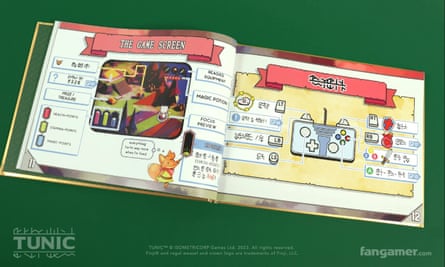Players of a certain age will no doubt have fond memories of the paper instruction manuals that once came with every video game. Dan Marshall, creator of The Swindle and Lair of the Clockwork God, certainly does. He remembers the ritual of poring over the manual for a new game on the bus ride home from the shops, trying to absorb all of its information in preparation for playing the game itself.
He vividly recalls receiving Bullfrog’s 1993 game Syndicate via mail order early one morning, then impatiently waiting hours for his brother to wake up so he could play it on the PC in his room. “And for that solid time I did nothing but read the manual over and over and over again,” Marshall says.
Marshall has now given away most of his old DVDs, games and magazines, but he still retains a shelf of treasured physical items that remind him of certain times in his life: the book he first used when learning to code, a 1989 Teenage Mutant Hero Turtles LCD handheld, the odd game box that he couldn’t bear to part with. “They’re things that you can walk past, and it brings a smile,” he says. “And a well done manual, a well done box, is joyful in that sense.”
In the early days of home video games, manuals were essential. Every byte of memory was precious, and even adding an instruction as simple as “press A to jump” would take up memory that could be better allocated elsewhere. Information about how to play the game could instead be offloaded to the manual, which also offered an opportunity to provide some story and background to accompany the simple sprites on screen. There might be other exciting things in the game box, too. Memorably, Revolution’s 1994 adventure game Beneath a Steel Sky came with a comic by 2000AD’s Dave Gibbons, which explained some of the events leading up to the game’s opening. The pioneering 1984 BBC Micro title Elite came with an entire novella called The Dark Wheel that gave insights into the Elite universe.
But as consoles and computers became more powerful throughout the 1990s, it became increasingly feasible to include instructions on how to play within the game itself. In-game tutorials soon became de rigueur, so players could dive straight into a new game without pausing to study the manual first. Then digital downloads started to take off in the 2000s. Initially, publishers would often provide a PDF version of the game manual, but eventually even this tradition tailed off. The instruction manual was redundant, dead.
However, a few developers have been working hard to resurrect this lost part of gaming tradition. The 2021 strategy title HighFleet: Deus in Nobis by Konstantin Koshutin arrived alongside a lovingly produced 92-page PDF manual that could be downloaded from Steam. The game was published by the newly reformed MicroProse, a company that has historically specialised in simulation and strategy games like F-15 Strike Eagle and Civilization, all of which came with suitably enormous manuals (the instructions for Civilization ran to well over 100 pages).
And earlier this year, Media Molecule released Tren for its Dreams game platform. The game is based around Brio-style wooden train tracks, and the company released a beautifully crafted digital manual to explain the “Tren Modular Play System”, a fictional toy produced by a company called BeechCorp. Brilliantly, the manual even features authentic-looking tea-ring stains and child graffiti.

We have seen a few developers try their hand at physical manuals, too. In July, The Banished Vault from Lunar Division featured an in-game manual that could also be ordered on paper, via print on demand, for £4.99. The developers were surprised at just how many players did exactly that: around 10% of people who bought the digital game purchased a paper manual as well. “Turns out folks never really tired of beautiful game manuals,” said Mike Bithell, the head of publisher Bithell Games, on X/Twitter. This is perhaps part of a wider trend right now in which physical objects are being venerated by a generation that has seen films, music and video games disappear into the digital realm – see also the younger generation’s unexpected fondness for vinyl.
Manuals can be playful, too. When Limited Run, a company that creates special-edition physical versions of retro and digital-only games, picked up Marshall’s game Lair of the Clockwork God in 2022, it asked him to create a manual to go with it. “And I said to them, could it be a manual for a different game?” Marshall says. He and collaborator Ben Ward thus came up with an instruction manual for a fictional kart-racing game called Unkarted Territory, which was created by an “insufferable indie developer called Tarquin,” who takes all of the credit while relying on others to do the work, says Marshall. The legal information on the first two pages heavily implies that the game might be haunted.
The in-game manual for the 2022 game Tunic by Andrew Shouldice, meanwhile, leans heavily into nostalgia for NES and SNES-era games such as The Legend of Zelda and Star Tropics; famously, the latter came with a letter that players had to immerse in water to reveal a hidden code. As with games of old, the elaborate artwork that the Tunic manual contains only vaguely resembles what’s on the screen. “One of the things that I mentioned to the artists was, bear in mind that this is harking back to an era where you probably got a pixel-art screenshot or a description of what was supposed to be here, and it probably doesn’t actually match the real game at all,” says Shouldice. In titles such as Star Tropics, he says, the video game itself was like peering through a keyhole into a world, “but the manual has a different view of it, and it shows how much more elaborate it is.”
after newsletter promotion

Tunic’s manual is authentic in another way, too, in that you actually need it to get through the game, which otherwise provides little guidance on how to progress. Pages of the manual can be found scattered across the in-game world, and each one gives a crucial piece of information: perhaps offering a map, or a plot revelation, or even revealing a special move. Each page is written in an indecipherable runic script, except for the odd tantalising English word here and there, harkening back to the days of playing imported games and attempting to decode the Japanese manual for hints about what to do.
Shouldice worked hard to make the in-game manual look authentically battered. “I made a physical booklet, and then distressed it – I tore parts and spilled stuff on it, then I put it in the tumble dryer a little bit to really mess it up,” he says. “Then I scanned all the pages.” The text was added digitally afterwards so that the manual could be easily translated into different languages. It is certainly a beautiful thing, and Fangamer has even produced a physical version of it for players to buy.

The Banished Vault also requires players to comb carefully through its manual: this turn-based title involves guiding a giant space monastery as it flees from solar system to solar system, reaping resources from planets and keeping a close eye on fuel levels, trying to escape a malevolent phenomenon. Nic Tringali, the game’s director, isn’t nostalgic for manuals: he only began getting into games as they were dying out. Instead, he was inspired by board games and tabletop role-playing games (TTRPGs). “In a modern TTRPG, the book is so well designed to teach you the system and flow you through this experience,” Tringali says. His idea was to use the same technique for a complex strategy video game.
“[In-game] tutorials are very complicated, and very prone to breaking when the interface changes or the design changes,” Tringali says, noting that it could end up having to be completely reworked late in development. “So I was looking at all that, and going, well, I think it’ll actually be less work to make a book.”
Developers and players may still have a soft spot for game manuals – but it’s difficult to imagine them making a comeback outside a few niche games. Dan Marshall thinks it’s a shame. “I would love to make a game that comes with a physical manual and you’ve got to read it,” he says. “There’s no tutorial, there’s no explanation for what the buttons do … imagine releasing a game where you can only have a physical copy. It would be a financial disaster, sure, but it would make a very small number of people our age very happy.”

